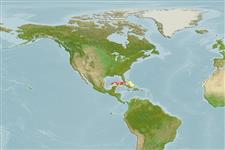Holocephali (chimaeras) >
Chimaeriformes (Chimaeras) >
Chimaeridae (Shortnose chimaeras or ratfishes)
Etymology: Hydrolagus: hydro-, combining form of hydor (Gr.), water; lagos (Gr.), hare, i.e., “water rabbit,” probably referring to three pairs of tooth plates, which tend to protrude from the mouth like a rabbit’s incisors (See ETYFish); alberti: In honor of Norwegian-born American oceanographer Albert E. Parr (1901‒1991), editor of the authors’ “Fishes of the Western North Atlantic” monographs, for his many contributions to ichthyology (See ETYFish).
Eponymy: Dr Albert Eide Parr (1890–1991) was an oceanographer and marine biologist who was born and raised in Norway, where he took his first degree at the University of Oslo. [...] (Ref. 128868), visit book page.
Environment: milieu / climate zone / depth range / distribution range
Ecology
Marine; bathydemersal; depth range 570 - 1470 m (Ref. 4443). Deep-water; 25°N - 21°N
Eastern Atlantic: Western Sahara and northern Mauritania. Western Atlantic: off Florida, USA (Ref. 4443) and off Suriname (Ref. 13608).
Size / Weight / Age
Maturity: Lm ? range ? - ? cm
Max length : 54.0 cm SL male/unsexed; (Ref. 4443)
Long caudal filament. Shorter dorsal spine, longer pectorals and a wavy lateral line. Dark brownish on head and body, fins much darker (Ref. 6902).
Oviparous (Ref. 205). Eggs are encased in horny shells (Ref. 205).
Life cycle and mating behavior
Maturity | Reproduction | Spawning | Eggs | Fecundity | Larvae
Krefft, G., 1990. Chimaeridae. p. 111-113. In J.C. Quero, J.C. Hureau, C. Karrer, A. Post and L. Saldanha (eds.) Check-list of the fishes of the eastern tropical Atlantic (CLOFETA). JNICT, Lisbon; SEI, Paris; and UNESCO, Paris. Vol. 1. (Ref. 4443)
IUCN Red List Status (Ref. 130435: Version 2024-2)
Human uses
Tools
Special reports
Download XML
Internet sources
Estimates based on models
Preferred temperature (Ref.
123201): 5.2 - 10.4, mean 6.6 °C (based on 25 cells).
Phylogenetic diversity index (Ref.
82804): PD
50 = 0.5000 [Uniqueness, from 0.5 = low to 2.0 = high].
Bayesian length-weight: a=0.00331 (0.00137 - 0.00798), b=3.07 (2.86 - 3.28), in cm total length, based on LWR estimates for this (Sub)family-body shape (Ref.
93245).
Trophic level (Ref.
69278): 3.8 ±0.6 se; based on size and trophs of closest relatives
Resilience (Ref.
120179): Low, minimum population doubling time 4.5 - 14 years (Assuming Fec <100).
Fishing Vulnerability (Ref.
59153): Moderate to high vulnerability (46 of 100).
